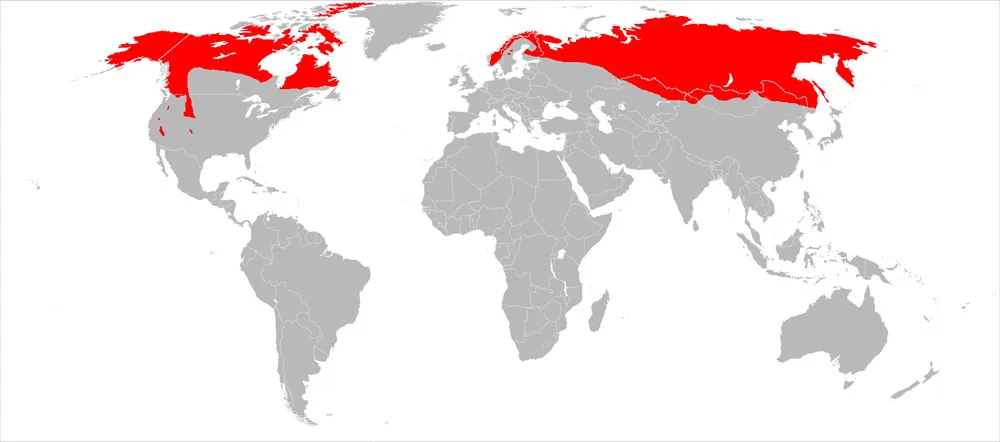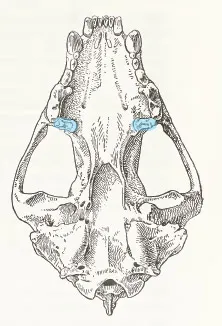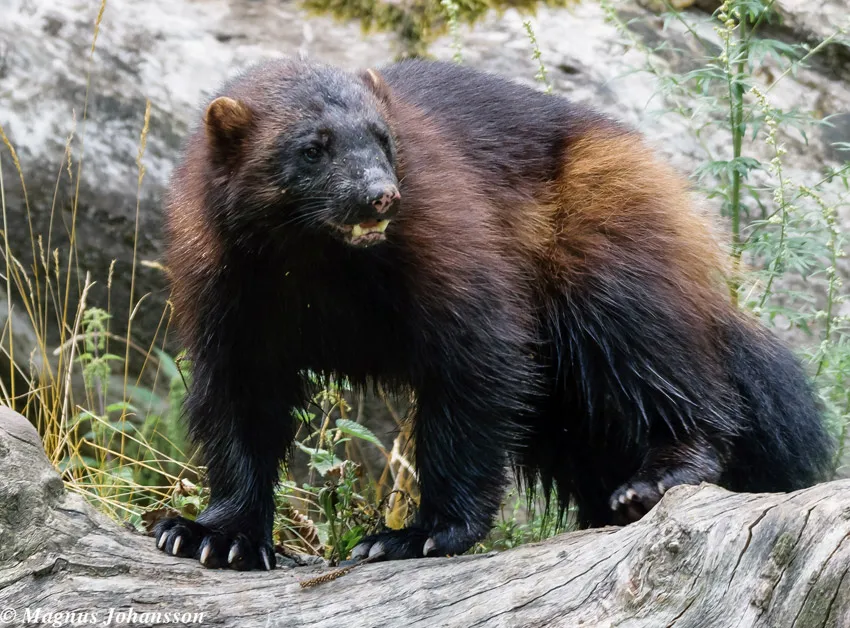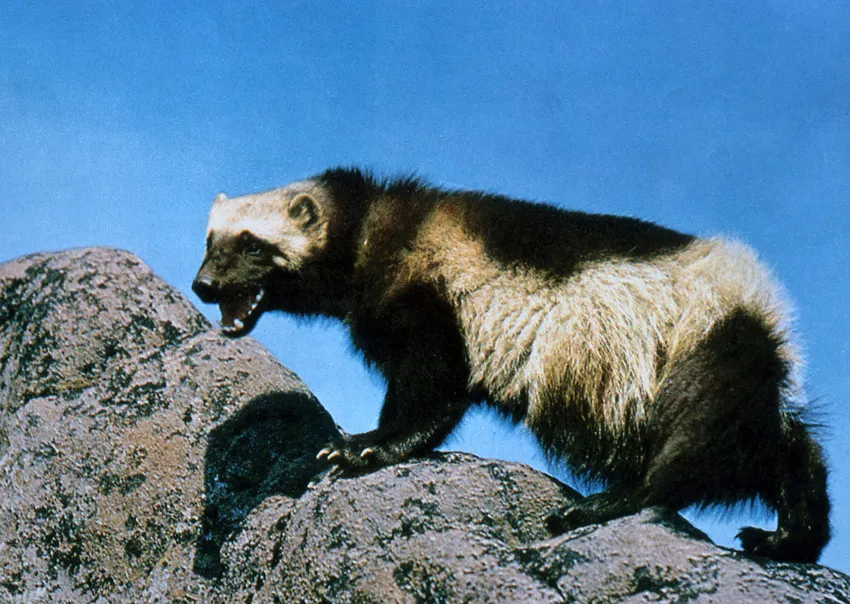Wolverine Animal - Facts and Adaptations
Gulo gulo
The wolverine is the largest member of the mustelidae, the weasels, it is stocky, muscular and looks more like a small bear though is the size of a medium dog. It has a reputation for toughness and strength beyond its size being prepared to tackle prey much larger than itself.
wolverine Basics
Average Weight: 9 to 25kg (20-55 lbs)
Average Length: 65 to 107 cm long (26 - 42
inches) plus a tail of 17 - 26 cm (12 inches), 20 to 30cm
(6.7 - 10.2 inches), shoulder height 30 - 45 cm (12 - 18
inches). Females are about 30% smaller than males.
Breeding Season: Wolverines are polygamous,
successful breeding males form long relationships with two
or three females. The breeding season is in the summer though
the species practices delayed implantation whereby the embryo
is held in a kind of stasis until the time is more appropriate
to continue development. Implantation won't take place
if food is scarce, the young (kits - typically 3) are born
between late February and April. Sexual maturity is reached
at two and a half years old, life expectancy is 4-6 years.
Estimated world population: - Wolverines
have very large home ranges in the region of 65-200 square
kilometers for females and 620 or more for males that overlap
the range of several females, so population densities are
naturally low. The world population is unknown, the highest
numbers are found in Canada and Alaska, probably in the
low 10's of thousands, Scandinavian and Russian populations
are in the high hundreds or low thousands. The enormous
range of wolverines brings them frequently into contact
and conflict with people, populations are generally declining
and they are becoming endangered in some parts of the range.
Feeding & diet: The wolverine's
Latin name Gulo means "glutton" indicative
of their feeding style which is an adaptation to potential
food scarcity, especially in the winter. They will feed
opportunistically on almost any animal food they find, most
of their diet consists of carrion, though they will hunt
almost any animal they encounter that is smaller or the
same size as they are. They will also attack much larger
animals such as adult deer, especially if they are weakened
or incapacitated by deep snow. They are a very well equipped
carnivores with sharp strong claws, powerful jaws and a
thick hide. They will defend their food whether they have
killed or found it against much larger predators even wolves
or bears and successfully take a kill from other predators.
In the winter in particular, they will hide excess food
away if it is too much to eat in one go so that other carrion
eaters won't get it, this is especially important to
nursing females.
Conservation status:
Least Concern, though with a declining population
and increasingly coming into conflict with humans, is likely
to be reassessed as more at risk in the future.
Distribution: Circumpolar usually in isolated
wooded regions. Females give birth to their young in dens
dug into the snow, this tends to restrict them to areas
where the snow doesn't melt until late into the spring.
Predators: Wolves and bears. The main
predator though is man, wolverine may come into conflict
with reindeer herders and sheep farmers, they are also been
traditionally hunted for their superior fur.

Distribution range of the Wolverine
What are Wolverine like? how do they survive?
 They
survive in some of the coldest places on earth all year round,
they have a number of anatomical, behavioural and physiological
adaptations that allow them to do this successfully.
They
survive in some of the coldest places on earth all year round,
they have a number of anatomical, behavioural and physiological
adaptations that allow them to do this successfully.Wolverine adaptations:
- Unique teeth (anatomical) - The last
molars are turned through 90 degrees (shown highlighted
in pale blue in the picture of a wolverine skull to the
right) which is used for breaking through bone and frozen
meat from carrion or a previously secreted cache.
- Relatively low surface area to volume ratio
(anatomical) - Like most cold climate animals,
the wolverine has relatively short legs, neck and smaller
ears. This means that there is less surface area to lose
heat from and makes it easier to stay warm in the cold.
- Large flat feet (anatomical) - To make
it easier to move through deep snow, they act like snow
shoes.
- Fearlessness and fearsome (behavioural)
- Tales of the ferocity of wolverine are legion, they have
remarkable toughness and tenacity in the face of apparently
overwhelming odds, whether defending their own food they
have killed or found, or in attempting to take food from
another predator. The primary means of killing is suffocation
whereby the wolverine grabs the prey by the throat and doesn't
let go, the powerful jaws and molars help crush too. There
is a record of a wolverine killing a polar bear in this
manner. This ferocity is also a wolverines main defence
against predators such as wolves and bears.
- Females are able to delay implantation of the
embryo (physiological) - Wolverines mate in the
summer and have a short gestation period of about 30-50
days, so delaying the development of embryos means that
their birth can be timed more appropriately for the following
spring. If conditions are particularly harsh over the winter
and the female is not well nourished during what should
be the main growth time for her offspring, then implantation
can be put off altogether.
- Females dig a den into a snow bank in order
to give birth and protect the young (behavioural)
- Wolverines get out of the worst of the cold and the wind
in late winter and early spring by digging a den to have
their babies. The flip side of this protective environment
is that wolverines are dependent on living somewhere there
is deep snow quite late on in the season and makes their
range susceptible to global warming.
- Very keen sense of smell (physiological) - Wolverines are able to smell dead animals that have been buried under deep snow by avalanches, an excellent source of food at a potentially very difficult time of the year.
Creative Commons Attribution 2.0 license - Left wolverine - Magnus Johansson
Creative Commons Attribution 3.0 license - IUCN - Distribution map
Creative Commons Attribution 4.0 license Top picture Wolverine - William F. Wood



